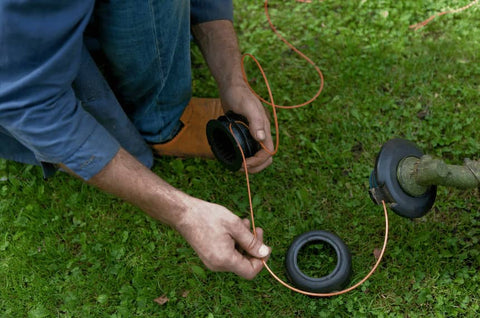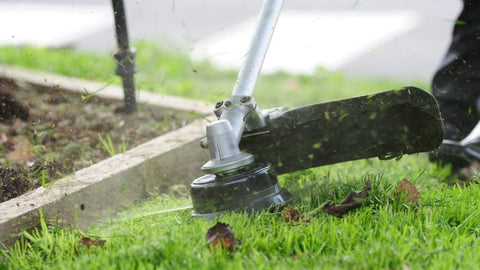A whipper snipper is a powerful tool in the gardener's arsenal, ideal for giving your lawn and garden edges that professionally manicured look. However, like any power tool, it requires knowledge and skill to be used safely and effectively. In this comprehensive guide, we delve into the best practices for using a whipper snipper, ensuring not only the safety of the user but also the achievement of optimal results.
Whether you're a first-time user or looking to refine your skills, this guide will provide valuable insights into getting that perfect trim while maintaining the highest safety standards.
Understanding Your Whipper Snipper

Before you start trimming and shaping your garden with a whipper snipper, it's crucial to understand the tool you are working with. Familiarizing yourself with its parts, functions, and the specific model you own lays the foundation for safe and effective use.
Basic Anatomy of a Whipper Snipper:
Motor or Engine: This is the heart of your whipper snipper, whether it’s powered by petrol, electricity, or a battery. It drives the cutting head to rotate the line or blade.
Cutting Head: Located at the bottom of the whipper snipper, this part holds the line or blade that does the actual cutting. The design can vary, depending on whether it's a line trimmer or has blade capabilities.
Shaft: This connects the motor or engine to the cutting head and can be straight or curved. The shaft's length and design can affect maneuverability and comfort.
Handle and Controls: The handle is where you grip the whipper snipper, and it typically houses the controls, like the throttle or power switch. Ergonomic handle design is key for comfortable operation.
Safety Guard: An essential feature, the safety guard helps protect you from flying debris during operation.
Familiarize Yourself with Your Model:
Read the Manual: Each whipper snipper model has unique features and operating instructions. Before using your whipper snipper, thoroughly read the user manual to understand its specific functionalities and safety features.
Know the Controls: Familiarize yourself with the start and stop mechanisms, throttle control, and any safety switches. Knowing how to quickly shut off the machine can be crucial in an emergency.
Check for Adjustments: Some models offer adjustable handles or shafts for better ergonomics. Adjust these to suit your height and reach for comfortable use.
Inspect Before Use:
Physical Inspection: Regularly inspect your whipper snipper for any signs of wear or damage, especially to the line or blades, safety guard, and connections along the shaft.
Maintenance Check: Ensure that routine maintenance tasks, such as line replacement, air filter cleaning (for petrol models), and battery charging (for battery models), are up to date.
By thoroughly understanding your whipper snipper and ensuring it is in good working condition, you set the stage for not just safe operation but also more effective and efficient garden maintenance.
Preparing for Use

Proper preparation is key to ensuring both the safety and effectiveness of your whipper snipper. This preparation involves performing safety checks, ensuring the tool is in good working condition, and wearing appropriate personal protective equipment (PPE).
Safety Checks and Pre-Use Maintenance:
Inspect the Whipper Snipper: Before each use, check the whipper snipper for any loose parts, damage, or wear, particularly in the cutting head and line or blade. Ensure that all nuts and bolts are tightened and that the safety guard is securely in place.
Fuel and Battery Check: For petrol models, check the fuel level and quality. For battery models, ensure the battery is fully charged and securely in place.
Line or Blade Inspection: Make sure the cutting line or blade is properly installed and in good condition. A worn line or dull blade can reduce efficiency and increase the risk of accidents.
Selecting the Right Personal Protective Equipment (PPE):
Eye Protection: Always wear safety goggles or glasses to protect your eyes from flying debris.
Hearing Protection: Use ear protection, especially with petrol models, to safeguard your hearing from the prolonged noise.
Sturdy Footwear: Wear robust, closed-toe shoes or boots for foot protection and better grip.
Leg Protection: Consider wearing long pants or specially designed protective leg wear to shield your legs from debris.
Gloves: Durable gloves can protect your hands and improve grip on the whipper snipper.
Familiarizing Yourself with the Operating Environment:
Survey the Area: Before starting, walk through the area where you'll be using the whipper snipper. Remove any debris, rocks, or objects that could be thrown by the cutting line or blade.
Plan Your Approach: Identify the areas that need trimming or edging and plan your approach. Be mindful of obstacles such as trees, garden beds, and fences.
Remember, a well-prepared gardener is both a safe and effective gardener. By following these preparation steps, you can ensure that your whipper snipper session is productive and enjoyable.
Basic Techniques for Trimming and Edging

Using a whipper snipper effectively requires mastering some fundamental techniques. Whether trimming grass or creating precise edges along pathways, these techniques are essential for achieving a neat and professional-looking garden.
Basic Trimming Techniques:
Proper Posture: Stand with your feet shoulder-width apart for stability. Hold the whipper snipper so its cutting head is parallel to the ground.
Sweeping Motion: Use a gentle sweeping motion side to side. The tip of the line does the cutting; avoid burying the head into the grass, which can overload the motor and create uneven cuts.
Cutting Direction: Trim with the cutting head rotating away from you to ensure debris is thrown away from your body. This also provides better control over the cutting line.
Height Consistency: Maintain a consistent height above the ground to ensure an even cut. Adjust your arm and body movement as needed to adapt to the contours of the land.
Edging Along Walkways and Beds:
Vertical Orientation: For edging, turn the whipper snipper so the cutting line is vertical. Some models have a special edging position or attachment for this purpose.
Steady Movement: Walk slowly along the edge, guiding the cutting line to trim grass overhanging onto pathways or garden beds. Keep the movement steady for a clean, straight edge.
Depth Control: Be mindful of the cutting depth to avoid damaging the roots of plants or creating too deep a trench along the edge.
Safety While Trimming and Edging:
Be Aware of Your Surroundings: Always be conscious of where you are trimming or edging, especially around trees, ornaments, or fragile garden elements.
Avoid Throwing Debris: Be cautious of the direction in which debris is thrown, particularly when working near windows, vehicles, or other people.
Learning and applying these basic trimming and edging techniques can significantly enhance the appearance of your garden. Not only do they ensure a more uniform and precise cut, but they also contribute to the overall health of your lawn and garden beds.
Advanced Trimming Techniques
Once you're comfortable with basic trimming and edging, you can explore more advanced techniques to handle challenging areas and different types of vegetation. These techniques will help you get the most out of your whipper snipper, allowing for a more professional finish and efficient garden maintenance.
Tackling Slopes and Uneven Terrain:
Safe Approach: When working on a slope, always trim across the slope, not up and down. This approach provides better balance and control.
Body Positioning: Keep your body weight centered and feet firmly planted to maintain stability. Use the whipper snipper’s strap or harness to help manage the weight.
Gradual Movements: Make gradual, controlled sweeps. Avoid aggressive cutting, which can lead to slips or uneven trimming.
Handling Thick Weeds and Overgrowth:
Power Setting: If your whipper snipper has variable power settings, use a higher setting for thick weeds. This provides more cutting power but be mindful of the increased wear on the line.
Cutting Technique: For dense vegetation, use a short, chopping motion. Cut from the top of the weeds and gradually move down to avoid tangling the line.
Clearing the Area: Periodically stop to clear away cut vegetation. This prevents clogging the cutting head and allows you to assess your progress.
Precision Work Around Delicate Areas:
Gentle Approach: When trimming around flowers, shrubs, or delicate garden features, use a slower, more precise cutting technique.
Shielding Plants: Use a hand or a physical barrier to shield plants or ornaments as you trim around them.
Line Length: Keep the line shorter to avoid accidentally cutting into areas you want to protect.
Creating Defined Borders:
Edging Technique: For a sharp definition between lawn and garden beds, use the edging technique with precision. Create a clear demarcation that adds to the aesthetic appeal of the garden.
Depth Consistency: Maintain a consistent depth along the edge for a uniform look.
These advanced techniques require practice and patience to master. However, once honed, they can significantly elevate the quality of your garden maintenance, allowing you to tackle a wide range of landscaping challenges with confidence and skill.
Safety Practices While Operating
Operating a whipper snipper safely is paramount to preventing accidents and ensuring a pleasant gardening experience. Here are essential safety practices to follow while using your whipper snipper:
Be Aware of Your Surroundings:
Stay Alert: Always be conscious of your environment. Be aware of people, pets, and property around you to avoid accidents.
Clear Area: Before starting, ensure that the area is clear of debris, toys, or other objects that could become hazardous if struck by the cutting line.
Proper Handling and Technique:
Controlled Movements: Maintain a firm grip and control over the whipper snipper at all times. Avoid overreaching or stretching beyond a comfortable position.
Avoid Forceful Contact: Do not force the whipper snipper into thick vegetation or soil. Let the tool do the work at its own pace to prevent kickback or loss of control.
Wearing Appropriate PPE:
Full Protection: As mentioned earlier, always wear the recommended personal protective equipment, including eye and ear protection, gloves, sturdy footwear, and leg protection.
Helmet and Face Shield: For heavy-duty trimming, consider wearing a helmet with a face shield for added protection.
Mind the Power Cord (For Electric Models):
Cord Management: Be mindful of the power cord’s location to prevent tripping or accidentally cutting it. Use a cord management system if available.
Dealing with Obstacles:
Approach Carefully: When trimming near fences, walls, or trees, approach cautiously to prevent damage to both the obstacle and your whipper snipper.
Use Proper Attachments: For difficult-to-reach areas, use appropriate attachments or switch to hand tools if necessary for safety.
Take Regular Breaks:
Avoid Fatigue: Regular breaks help prevent fatigue, which can lead to accidents. Take a moment to rest, especially during prolonged use or in hot weather.
Post-Operation Safety Check:
Cool Down: Allow the whipper snipper to cool down before storing or performing any maintenance.
Inspect for Damage: After use, inspect the tool for any damage or wear that may need attention before the next use.
Adopting safe operating practices is crucial for any gardener using a whipper snipper. These practices not only ensure your safety but also the safety of those around you and the longevity of your tool.
Conclusion:
Mastering the use of a whipper snipper is a journey that combines understanding the tool, preparing properly, and applying effective trimming techniques. Through this guide, we've explored the nuances of operating a whipper snipper safely and efficiently, from basic trimming to advanced techniques.
The skills and knowledge you develop through this guide will not only enhance the appearance and health of your garden but also ensure your safety and the longevity of your tool. Remember, the key to successful whipper snipper use lies in a blend of practice, patience, and attention to detail.
If you're in search of the perfect whipper snipper to start or enhance your gardening journey, you should consider checking our selection. Our trimmers are suited to different garden sizes and user preferences, each designed to make your gardening tasks more efficient and enjoyable. We also offer a wide range of equipment for your heavy-duty tasks.
Here's to beautiful gardens and enjoyable gardening experiences with your trusty whipper snipper!

